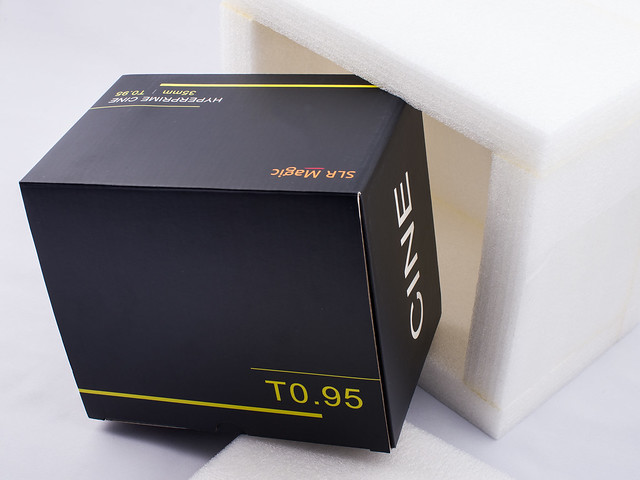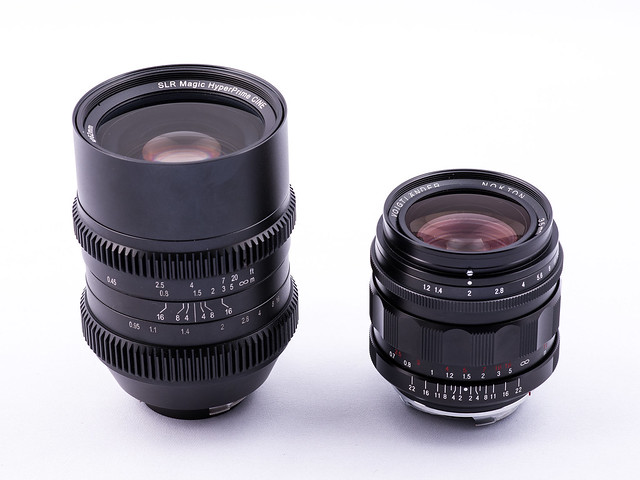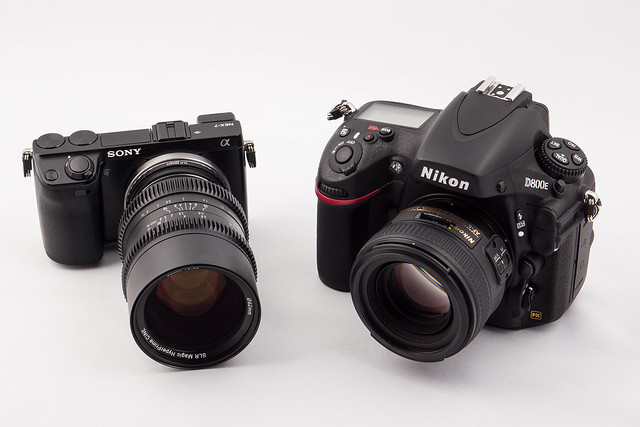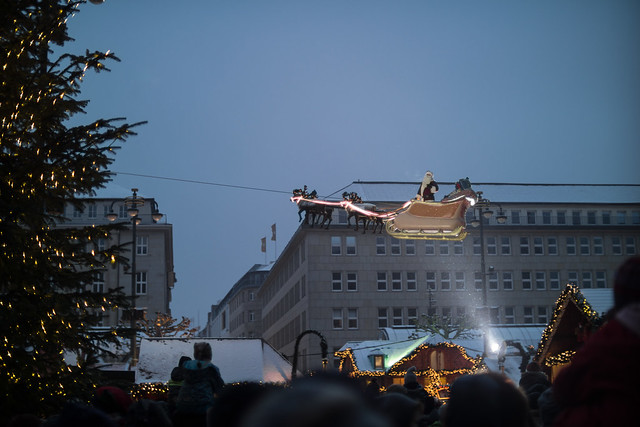Right on time for Xmas, the latest masterpiece from SLR Magic - the HyperPrime CINE 35mm T0.95 - arrived here in Germany. If you have seen my article about the first prototype that was presented in September on the "Photokina 2012" exhibition in Cologne, you can imagine my enthusiasm, when the box was delivered by the postman. Here we compare that exceptional piece of glass & metal to a 50mm F1.4 lens on a fullframe camera (Nikon D800E) and to a Voigtlander Nokton 35mm F1.2 ASPH (version I), that was - up to now - the fastest 35mm lens that you could get with Leica M mount.
First let us take a look at the lens and its box. After some discussion about the packaging of its "big brother", the HyperPrime CINE 50mm T0.95 (see my review here), SLR Magic created a high quality box for that lens and wrapped it for shipment into another shock absorbing foam box, that makes already the unboxing a nice experience:
In the box you find the lens protected with two metal lens caps and an adapter with another cap for the target mount. The lens itself is equipped with M-mount and depending on the camera system that you ordered it for, it is packaged with an adapter for either E-mount (Sony NEX), X-mount (Fuji X), EF-M mount (EOS M) and mFT. Due to the large transmission, the lens design required a large rear element (approx. 36 mm diameter), that will not fit into the throat of current Leica M cameras and not into Ricoh GXR M-modules as well.
If you compare the lens to the Voigtländer Nokton 35mm F1.2 ASPH (version I), you see what it means to gain even about one additional F-stop. It is built very solid and as it does not use aspherical elements, it is comparable regarding size and weight (about 800g) already with the Leica Noctilux M 50mm F0.95:
The lens comes with an extractable lens hood and a 62mm filter thread. The stepless aperture ring is calibrated in T-stops (metering the transmission), typically for most of the "CINE" lenses from SLR Magic. Interesting for movie makers: The aperture and the focus ring have notches allowing to be driven directly in rigs with a follow focus. As you may have seen already in my Photokina article on this photo, the lens provides an image circle covering the APS-H sensor format but not fullframe sensors.
So what means T0.95? The aperture is calibrated in T-stops as film makers must make sure that the light transmission keeps continous when changing lenses at the same T-stop whereas F-stops only describe the calculated ratio of focal length and how wide the lens can open. Due to vignetting and other properties of the lens design, a T-stop of 0.95 typically requires a F-stop of about 0.9 at open aperture which makes it the fastest 35mm lens for APS-C/H and mFT sized sensors, opening a new performance level.
Compared to the prototype shown on the Photokina, several optical and mechanical optimizations were applied. Aperture and focal rings swapped their positions and glass elements were replaced by different glass and a better coating in order to reduce CA and PF (chromatic aberrations and purple fringing). The HyperPrime CINE 35/T0.95 allows a close focus of 0.23 m. Andrew Chang, product manager of SLR Magic told me that the - already amazing - prototype was able to deliver about 70% of the performance of the final design. The lens shown here is already final regarding optical design but the production version will receive some minor improvements for the aperture early 2013.
Sharpness
THIS lens is already pin sharp when used at open aperture!!! Please look at this example shot with Sony NEX-7:
100% crop (actual pixels):

In a later update of this review we will see also examples at other aperture settings - but as most people who intend to buy such a lens are "bokeh maniacs", stopping down this lens is like cooking champaign. So let us come to the supreme discipline for such a light monster:
Shooting at available light
If you love it, when people pop out sharply rendered from a smooth and creamy background with nice circles of confusion from highlights instead of "dead-flashed", flat pictures, you propably know that this requires a shallow depth of field (DOF) and that this - physically - can be reached only with large apertures. The smaller the camera sensor, the larger must be the aperture in order to reach a comparable available light performance and DOF. At the classic "half portrait" viewing angle of about 40° horizontally, on a film or fullframe camera you typically use a 50 mm focal length with an aperture of F1.4 in order to be able to play nicely with DOF. Translated to the 1.5x crop factor of an APS-C sensor that means you would have to shoot with a lens of about 35mm focal length at an aperture of about F0.9 in order to reach the same shallow depth of field at this field of view. Till this day this was simply not possible due to the lack of such a lens. The fastest 35mm lens available so far was the legendary Voigtlander Nokton 35mm F1.2 ASPH which was replaced by Cosina with a slightly smaller version II in 2011 with different glass and a modified focus throw allowing (scale) focussing starting at 0.5 m (0.7 m for version I).
Before we come to a bokeh comparison, let us take a look at a situation with VERY little light. The main light source here is the display of the cell phone, the beauty holds in her hand and even with T0.95 / F0.9 the camera already tuned up to ISO 1600 in order to keep 1/60s shutter time for minimizing motion blur in a portrait at this viewing angle:
Bokeh comparison
Another important discipline is the rendering of out-of-focus areas, commonly described with "bokeh". Bokeh-lovers prefer lenses that render a smooth & "creamy" bokeh with neutral circles of confusion shaping around highlights in the background. In this comparison we check the bokeh of two 35mm lenses attached on the Sony NEX-7 with pictures taken with a fullframe camera (the amazing Nikon D800E) equipped with a 50mm F1.4 lens (AF-S Nikkor) providing a comparable viewing angle and DOF at open aperture.
1. Nikon D800E + AF-S Nikkor 50mm F1.4 G:
...and crops from that picture scaled to a comparable resolution shown afterwards for the NEX-7 pictures:

2. Sony NEX-7 + Voigtlander Nokton 35mm F1.2 ASPH (version I):
...and crops from that image at comparable resolution:
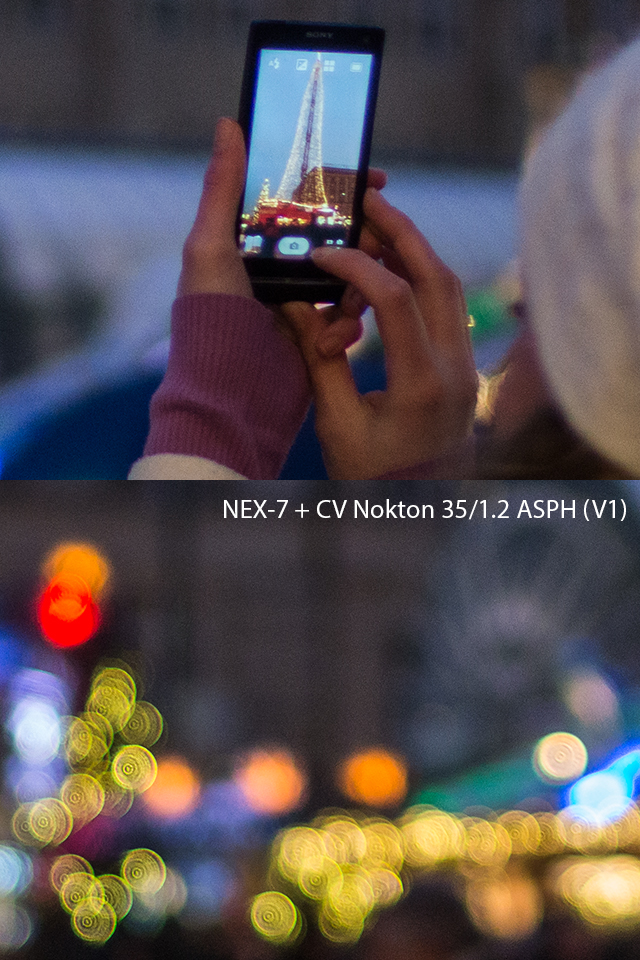
3. Sony NEX-7 + SLR Magic HyperPrime CINE 35mm T0.95:
...and crops from that image:

The difference is obvious especially in the way, the circles of confusion from the highlights in the background are rendered. The NOKTON creates "onion rings" that are surely not everybodys taste whereas the HyperPrime CINE renders very neutral circles.
You see that difference even more when you compare the title image with two comparable shots taken with the alternatives:
1. Nikon D800E + AF-S Nikkor 50mm F1.4 G:
...and a crop from that picture scaled to a comparable resolution shown afterwards for the NEX-7 pictures:
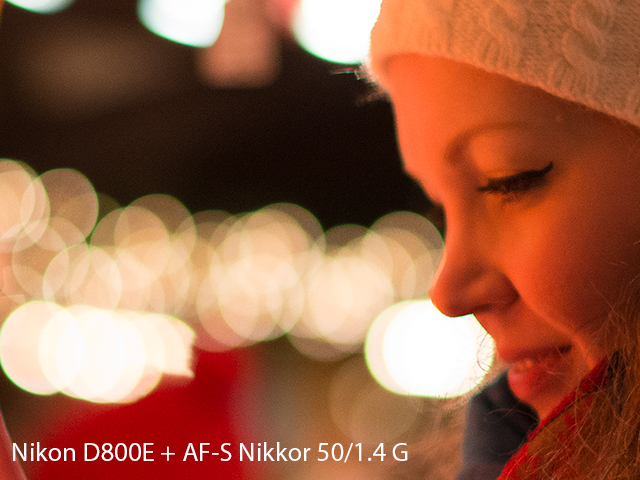
2. Sony NEX-7 + Voigtlander Nokton 35mm F1.2 ASPH (version I):
...and a crop from that image at comparable resolution:

3. Sony NEX-7 + SLR Magic HyperPrime CINE 35mm T0.95:
...and a crop from that image:
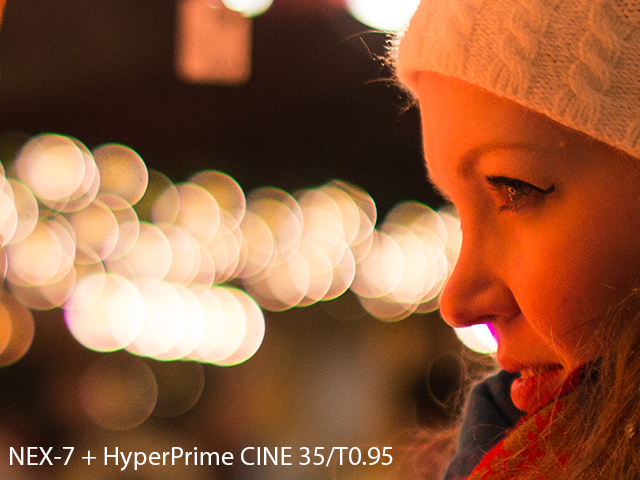
If you wonder why the images from the Nikon D800E contain a comparable level of noise, you must know that the fullframe shots were taken with a shutter speed of 1/200s compared to 1/60s used on the NEX-7. This required a significantly higher ISO amplification. I got used to these short shutter speeds in order to prevent motion blur even at the "microscopic" full resolution (36 MP) although this was not really required for this comparison. Some D800E shots were even taken with ISO 6400 and I think I do not have to explain what had been left with that setting on a Leica M9 / M9P...
Further characteristics
As with practically all lenses allowing apertures wider than F1.4, you'll find also with this lens some chromatic aberration (CA) in areas with extreme contrast at open aperture. But compared to the prototype sample tested at the Photokina, the CAs were significantly reduced and can be controlled easily in post processing. The purple fringing that I saw with the prototype copy could not be reproduced anymore thanks to the different glass and coating of the production version.
What you may find else at open aperture is some vignetting and aspheric lens coma abberration in the borders and edges as visible in this example, when you click on the picture to see other sizes:
These effects are common for bright lenses and the competitors I have seen so far show this as well - usually stronger. Coma and vignetting will disappear when stopped down to approximately T1.8.
Conclusion so far
After the first look in September at the already surprisingly good prototype, it was amazing to see how SLR Magic could even increase the performance of that lens in the meantime. Thanks the new coating, CAs are almosty completely gone. The build quality is very good, sharpness, contrast and bokeh at 35mm on APS-C (comparable to 52mm on fullframe) are even at open aperture as good as the best 50/1.4 lenses I have seen so far on FF. You can find a comparison to the Leica "M" (Typ 240) with attached Summilux 50/1.4 ASPH here.
Only downside is a strong field curvature and the size and weight as you will loose the compactness advantage, that APS-C lenses and cameras typically provide compared to bulkier fullframe equipment. And of course you must accept that manual lenses do not provide the speed advantage of autofocus systems but setting an accurate focus with this shallow DOF in low light situations is a challenge where most autocus systems have a disappointing hit rate anyway.
According to a first announcement this lens will be priced at US$ 1249.
Finale
After the "big brother", the HyperPrime CINE 50mm T0.95 already attracted me as a very special portrait lens for APS-C sizes sensors, now the CINE 35mm T0.95 is even more inspiring due to its greater flexibility. Let me share some of those inspiring pictures with you at the end. All the examples were shot at open aperture as well. You can click on all those images in order to see larger sizes.
Thank you "Glückskind" and "Anja" as well for your participation and inspiration.
If you are interested in preordering the lens, please feel free to contact support (at) slrmagic.com by e-mail.
Update:
Some people seem to think that the Mitakon 35mm F0.95 lens and the SLR Magic HyperPrime 35mm T0.95 are identical lenses. Of course they are NOT. The Mitakon 35 F0.95 and the SLR Magic HyperPrime 35mm T0.95 are different constructions, you can find a comparison here.
All images copyright by 3D-Kraft.com.




